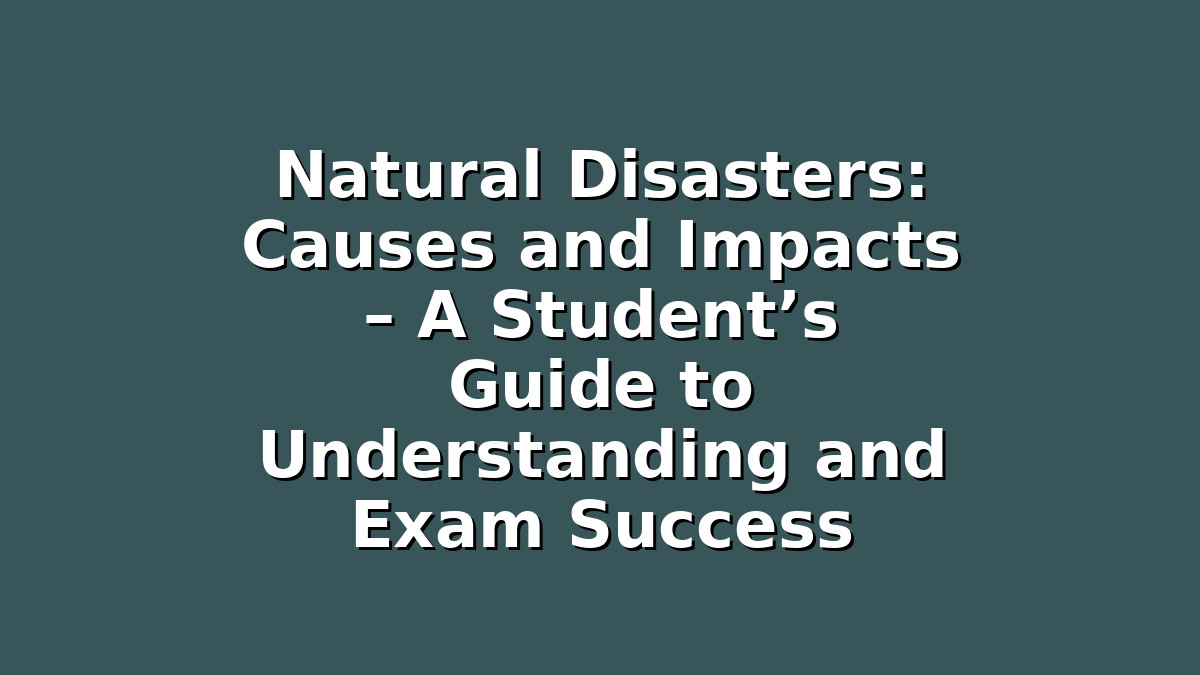Preparing for exams can be stressful, especially when your syllabus covers complex topics like natural disasters. Understanding the causes and impacts of natural disasters is not only important for science and geography subjects but also helps you develop critical thinking about environmental issues. This comprehensive guide will walk you through the key concepts and offer practical study tips to help you master this topic confidently.
Introduction
Natural disasters are powerful, often sudden events caused by natural forces that can have devastating effects on people, property, and the environment. From earthquakes and hurricanes to floods and volcanic eruptions, these events shape our planet and challenge human resilience. As students, grasping the underlying causes and the wide-ranging impacts of natural disasters is essential for exams and real-life awareness.
This article breaks down the topic into three main sections: the causes of natural disasters, the impacts they create, and effective study strategies tailored to this subject. By the end, you’ll not only understand natural disasters better but also have a handy toolkit to prepare for your exams efficiently.
—
1. Understanding the Causes of Natural Disasters
Natural disasters occur due to various physical processes happening inside and on the Earth. Knowing these causes is the foundation of your study.
Key Causes to Remember:
– Tectonic Plate Movements: The Earth’s crust is divided into plates that move slowly. When these plates collide, slide past, or pull apart, they cause earthquakes, volcanic eruptions, and tsunamis. For example, the 2011 Japan earthquake was caused by the movement of the Pacific plate under the North American plate.
– Atmospheric Conditions: Hurricanes, cyclones, and tornadoes form due to specific weather patterns, such as warm ocean water and atmospheric instability. Understanding how these weather systems build can help you predict their occurrence.
– Climatic Changes: Prolonged droughts or heavy rainfall can cause floods and landslides. These are often linked to seasonal changes or climate phenomena like El Niño.
– Volcanic Activity: Magma from inside the Earth can erupt through volcanoes, releasing lava, ash, and gases. Volcanic eruptions can be explosive or gentle but often have widespread effects.
Study Tips for Causes:
– Create Mind Maps: Visualize the causes by drawing mind maps linking each disaster type to its cause. This helps in retaining complex information.
– Use Mnemonics: For example, use “TACV” to remember Tectonic, Atmospheric, Climatic, and Volcanic causes.
– Practice Diagram Labeling: Many exams ask you to label diagrams of tectonic plates or hurricane formation. Practice these to strengthen your understanding.
—
2. Exploring the Impacts of Natural Disasters
Natural disasters affect communities, economies, and the environment in multiple ways. Exam questions often focus on these impacts, so it’s crucial to understand them clearly.
Types of Impacts:
– Human Impacts: Loss of life, injuries, displacement, and psychological trauma are immediate effects. For instance, floods can force hundreds of thousands to leave their homes.
– Economic Impacts: Destruction of infrastructure, homes, and businesses leads to huge financial losses. Recovery can take years, affecting national economies.
– Environmental Impacts: Soil erosion, water pollution, and habitat destruction can occur. Volcanic ash, for example, can damage crops but also enrich soil in the long term.
– Social Impacts: Disasters may disrupt education, healthcare, and social services. Communities may experience long-term changes in demographic patterns.
Study Tips for Impacts:
– Use Real-Life Case Studies: Linking theoretical knowledge with real events makes it easier to remember. For example, study the 2004 Indian Ocean tsunami’s impacts.
– Summarize in Tables: Create tables comparing different disasters, listing their human, economic, environmental, and social impacts side by side.
– Practice Cause-Effect Questions: Write practice answers explaining how a specific cause led to certain impacts, which is a common exam format.
—
3. Effective Study Techniques for Natural Disaster Topics
Studying natural disasters requires understanding scientific concepts and being able to apply them. Here are some strategies tailored for students preparing for exams.
Active Learning Methods:
– Flashcards: Make flashcards with key terms (like “magnitude,” “storm surge,” “epicenter”) on one side and definitions on the other. Review them regularly.
– Group Discussions: Talk about natural disasters with classmates to deepen your understanding and hear different perspectives.
– Teach Someone Else: Explaining what you’ve learned to a friend or family member reinforces your knowledge.
Memorization and Application:
– Use Past Exam Papers: Practice questions from past papers help familiarize you with question styles and time management.
– Incorporate Diagrams: Many exams require drawing or interpreting diagrams. Practice sketching plate boundaries, weather patterns, and disaster impacts.
– Link Concepts to Current Events: Following news about recent natural disasters makes your study relevant and helps you remember details.
Managing Exam Stress:
– Set a Study Schedule: Break down your revision into manageable chunks with specific goals.
– Take Breaks: Short breaks during study sessions improve concentration.
– Stay Positive: Remember that consistent effort leads to improvement—natural disasters may be complex, but you can master them with practice.
—
Conclusion
Understanding natural disasters—their causes and impacts—is vital for academic success and becoming a well-informed global citizen. By breaking down the topic into manageable sections and using active study techniques, you can approach exam preparation with confidence. Remember, the key is not just memorizing facts but connecting ideas and applying them to real-world situations.
Keep practicing diagrams, reviewing case studies, and discussing with peers. With dedication and the right strategies, you’ll be well-prepared to tackle questions on natural disasters and excel in your exams.
Good luck, and stay curious!
—

Responses